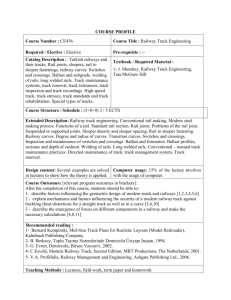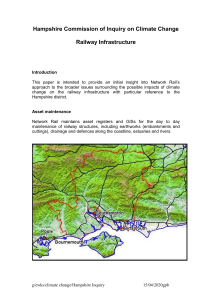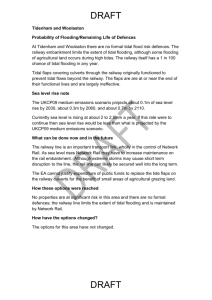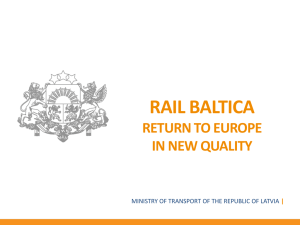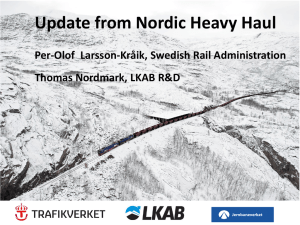Student handbook - Curriculum Support
advertisement
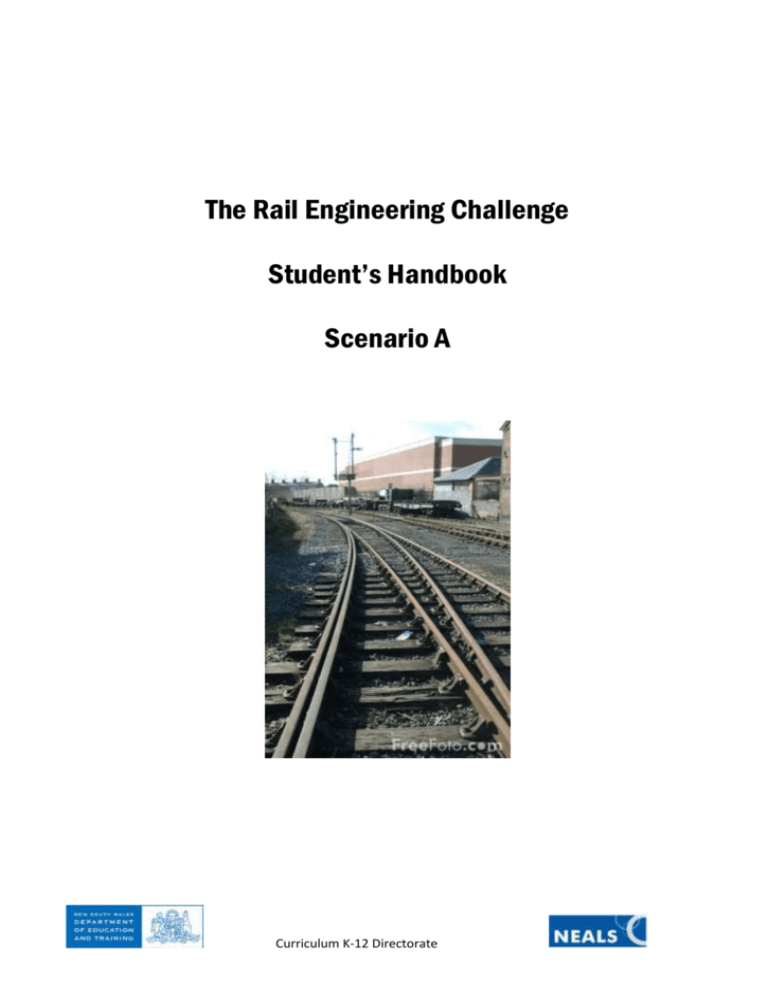
The Rail Engineering Challenge Student’s Handbook Scenario A Curriculum K-12 Directorate The Rail Engineering Challenge - Scenario A Acknowledgements The Rail Engineering Challenge was originally developed as a partnership between RailCorp and the Curriculum K–12 Directorate of the NSW Department of Education and Training as the Making Tracks program. Materials were developed by: Bill Blake Technology Unit, Curriculum K–12 Directorate NSW DET Peter Dawes Northern Beaches Secondary College, Manly Selective Campus Lyndall Foster Technology Unit, Curriculum K–12 Directorate NSW DET John Gibson Heritech Consulting Julie King Technology Unit, Curriculum K–12 Directorate NSW DET Rebecca Prentis RailCorp We would also like to thank the following people for assisting in the development of The Challenge: Andrew Chilov RailCorp David Foldi RailCorp Dev Kumar Cherrybrook Technology High School Ruth Mason Centre for Learning Innovation, NSW DET Phil Meurant RailCorp Rod Nesbitt Baulkham Hills High School John Paff RailCorp John Perdriau Mosman High School Steve Russell Centre for Learning Innovation, NSW DET Richard Singleton RailCorp Graeme Smith The Forest High School Dominique Tubier RailCorp Robert Ujszaszi RailCorp © State of New South Wales through the NSW Department of Education and Training, 2010. This work may be freely reproduced and distributed for most purposes, however some restrictions apply. Student’s handbook page 2 The Rail Engineering Challenge - Scenario A Contents Overview 4 The scenario 5 What does the student team need to complete? 7 The team and their roles 9 Resources 12 Seeking advice from practicing engineers 12 Student’s handbook page 3 The Rail Engineering Challenge - Scenario A Overview The Rail Engineering Challenge highlights rail engineering as a potential career and provides a powerful way for students to learn about contemporary rail engineering. Teams consisting of 4–6 students are encouraged to enter. A series of design and production activities in class will lead to the development of team submissions. Students identify and explore real issues; generate and refine ideas; and model and document their solutions. The Rail Engineering Challenge provides teachers of Stage 5 Industrial Technology: Engineering with a practice-based professional learning program that includes a well scaffolded teaching and learning sequence. The program also supports teachers in the implementation of quality teaching practices by putting into practice well researched principles of learning that emphasise the value of authentic, relevant subject matter, explored through practical, action-oriented projects. The Challenge Each team is to design a new railway system for a hypothetical location not currently serviced by train, solve specific problems related to the development of the new system and create a model of a section of their new railway system. To succeed in The Challenge, the teams must have an understanding of the different engineering roles that exist, and how they work together. These engineering roles can include civil, electrical, mechanical and signal design engineering and project management. The scenario consists of a detailed topographic map showing the geographical area for which the new system is being developed and a set of design specifications which will be used to inform student decisions throughout the project. Teams plan an appropriate route for the new railway system, taking into account: geography and topography, demographics, cost effectiveness and social and environmental impacts of the new railway system. Teams will submit: • • • • Engineering Report containing design development, analysis and evaluation of the solution. A3 map of the proposed route for the new system. Scale model of a short section of the railway system. Team presentation. Student’s handbook page 4 The Rail Engineering Challenge - Scenario A The scenario Your challenge is to design a new railway system to service the town of Fauxton. Fauxton is a growing coastal town not currently serviced by train. A plantation logging industry is opening up in the Radiata Pine forest planted near the town 80 years ago by Forests NSW. This industry will provide new jobs, attracting more people to the town. The planning authority has decided that the Fauxton area needs a rail system linked to the existing system. They are seeking your engineering expertise in the design of a new railway system to connect the town and its budding industry to the existing rail network. The railway must work alongside the current road transportation options; it should also be cost effective. The projected town population in ten years time is 320,980. The new railway system should be designed to accommodate this projected population. Initial surveys suggest that 30% of the population would make regular use of the new railway system during the 2 hour morning peak hour period. It is assumed that the proportion would remain constant as the population increases. A system based on this load will also meet the reduced post peak hour demand. Based on the survey, the new system will need two stations to service the urban area and a terminal to service the logging industry. The station at East Fauxton is expected to handle 60% of passengers at peak times and 40% at West Fauxton. The environmental impact study (EIS) An EIS was completed by the railway developer and exhibited to the public. Environmental factors such as the effect of the project on sensitive flora and fauna habitats, possible air and water pollution and maintaining wetlands and other ecosystems or natural communities were evaluated. Other factors such as noise pollution and how it can be minimised and social factors such as access to transport for work and leisure were also considered. In response to the EIS, submissions were received by the Land and Environment Court from the local LandCare Group, Chamber of Commerce, Tourism Board, Public Transport Lobby Group and the Timber Industry. Generally the proposal was positively received; however the Commissioner from the Land and Environment Court has identified the following issues to be addressed in the final design: If the track is to pass through the built-up areas shown on the topographical map a tunnel must be used. The effect of the rail noise on the inhabitants of Fauxton and strategies for its minimisation. Geotechnical survey results indicate that the bed of the Winding River, up to 4 kilometres Student’s handbook page 5 The Rail Engineering Challenge - Scenario A from the river mouth, is not suitable as a foundation for major load bearing structures such as bridge piers due to a particularly deep deposit of unstable clay in this area. A recent survey of the Winding river ecosystem discovered a sensitive marine habitat around an island in the Winding river and the river downstream of the island. This habitat supports several species of aquatic flora and fauna that are considered at risk. The survey recommends that that these areas are preserved in their current state to allow the habitats for the endangered species to flourish. As developers of the new rail system you have been asked to consider a route for the new rail system that will minimise disturbance to this sensitive habitat. In the rationale in the engineering report include how these points have been addressed. As the project managers and engineers assigned to this project, your team will develop Fauxton’s new railway system. The guidelines in this Handbook will assist you with the project. For technical data and definitions of rail terms see the separate Design Specifications Booklet. A topographical map for the Fauxton local area. Map Notes The creeks on the maps are all less than 20m wide. The winding River is more than 20m wide throughout its length shown on the map. The width of the river through the swampy area can be determined by using the map scale. The last substation is located 3km before the end of the existing line. Press Release During the planning and construction of any large new infrastructure projects, issues will arise that the planning team will need to resolve. An issue of concern will be outlined in a press release that will be forwarded to you from your teacher during week 3 of the task. Student’s handbook page 6 The Rail Engineering Challenge - Scenario A What does the student team need to complete? 1. Engineering Report (in A4 format) The student team will produce an engineering report featuring: • • • An Executive summary of the key features and benefits of the proposed solution. (up to 200 words) The criteria to be considered and addressed in developing the team’s solution. (up to 200 words) An identification of the features of the proposed solution (shown on the map) and a justification of the choice of route: rail corridor and tracks; location and length of any cuttings; location of any embankments, bridges, tunnels, station platforms, maintenance buildings, signals, signal boxes and electrical substations. The justification should be consistent with advice in the Design Specifications. (up to 400 words). • A rationale for the design solution based on: – the engineering concepts outlined in the Design Specifications – geographic and demographic considerations – social impact – environmental impact – economic factors. (up to 600 words) • A timeline used in managing the project. It could take the form of a spreadsheet or Gantt chart that shows all the activities that need to be completed to finish the project, the estimate of how long each activity will take and a record of how long each activity actually took. (one A4 page) • A budget analysis detailing the cost of the railway system and its passenger carrying capacity. It will contain a breakdown of the costs of the various components of the railway system design and the total projected cost. It will also include an estimate of the peak passenger carrying capacity of your railway system design based on the information in the Scenario and headway calculations. (one A4 page) • An evaluation of the process followed by the student team. It should include evidence of an understanding of the roles of engineers and how engineers work together as a team. (up to 200 words) • An acknowledgement of any references such as websites and books and any people who assisted in the development of the solution. • Appendices documenting the design development including research, calculations, sketches and plans for the railway system design and the model. 2. A3 map of the proposed route of the new railway system The student team will draft: Student’s handbook page 7 The Rail Engineering Challenge - Scenario A the route of the proposed new railway system by hand onto the supplied A3 size topographical map (1:25,000) or electronically onto the supplied PDF file of the map. The map will include the rail corridor and the tracks as well as location and lenghts of any cuttings, embankments, bridges, tunnels, station platforms, maintenance buildings, signals, signal boxes and electrical substations. These will be drawn to scale and use typical and supplies topographic mapping symbols. 3. Scale model of a short section of the railway system The student team will produce a model: of a level crossing where the rail line crosses the road that services the logging industrycalled Forest Road. The model will: - be based on the scale of a section of track used in model railways. - include a working electronic circuit to simulate signalling at the level crossing. - include brief written instructions to explain the operation of the model. NOTE: the model components are not to be bought as a kit 4. Team presentation The presentation will consist of the student team: Justifying the proposed route of the railway system (up to 5 minutes) Demonstrating the level crossing model and explaining the main signal engineering features ( up to 5 minutes) Responding to questions raised by teacher and other student groups NOTE: All members of the team must participate in the delivery of the presentation Student’s handbook page 8 The Rail Engineering Challenge - Scenario A The team and their roles Consider your team in The Challenge as the project management team assigned to the development of Fauxton’s new railway system. There are five roles within the team, you may decide to have one person for each role or have roles shared by members of your team. Discuss this with your team and decide how it will best work for you. Your teacher will guide you through the sequence of activities, but it helps to understand each role. Read the outline of activities for each role below. 1. Project manager The project manager will be responsible for coordinating the work of the team, collating information and research, tracking costs, and monitoring the timeline. As project manager your tasks include: a. Managing the project with the team and checking progress. b. Creating and monitoring the timeline for the project so it is completed by the due date. c. Assisting the team with research. d. Coordinating activities for the group. e. Analysing the Budget to minimise construction costs, i.e. bridges, tunnels, platforms, length of tracks, signals and estimating the final cost of the new railway system. Use the Costing guide in your Design Specifications Booklet. This information will be recorded in the budget analysis of the engineering report. f. Considering the social and environmental effects of the new railway system. List any impacts (positive or negative) you think the railway will have on the community and environment. These will be included in your engineering report. g. Evaluating the railway system solution. This will be included in your engineering report. 2. Civil engineer Civil engineering in rail involves following systems, standards and design principles that enable safe efficient movement of trains on the line. It involves repairing and maintaining infrastructure and bridge construction and design. a. Deciding where it is feasible to locate the tracks, platforms, bridges, tunnels, and level crossings and how many are needed to support the system. Determine with your team how the railway will run through the town by deciding where the railway structures best fit. Student’s handbook page 9 The Rail Engineering Challenge - Scenario A b. Studying the natural features of the proposed route and referring to the Student Handbook to plan the track layout. See the Design Specifications Booklet for information on track components, layouts etc. c. Documenting your reasons for where the chosen track is to be placed. Identify the features of the proposed route and justify the choice of the route. This will be included in your engineering report. d. Considering ways to assist with improving the environment when you create this railway system. Record any factors you should consider in relation to how to best fit the railway system into the town’s current urban surroundings, i.e. creation of garden beds next to line to fit in with current landscape. You may also wish to consider things like solar powered lighting, or bike interchanges near the station. 3. Mechanical engineer The mechanical engineer is part of a design team that is responsible for the design, modification and maintenance of our trains. They look at the availability of the trains, the number of passengers they can take, and what trains to run. As a mechanical engineer your tasks include: a. Determining the best type of rolling stock to use for the town. b. Ensuring the appropriate structures (bridges, tunnels) are selected. Refer to your Design Specifications Booklet for definitions and rolling stock (train) information. c. Completing noise studies. Record information on the noise that may be generated by your new railway, and who will be affected. Also note anything that can be implemented to reduce the noise pollution. This will be part of the rationale in the engineering report. d. Deciding where to build the maintenance shed and wash plant. You will need one maintenance area for the new rail system. Justify your decisions in the engineering report. e. Determining how many trains will need to be run to service the population of Fauxton. Refer to the Rolling stock information in the Design Specifications Booklet. The numbers of train services will be included in the budget analysis in the Engineering Report Student’s handbook page 10 The Rail Engineering Challenge - Scenario A 4. Signal engineer The signal engineer is a role unique to the railways industry. Signal engineers develop systems to ensure the trains operate safely and do not collide with one another on the tracks. They engineer protective systems like signals, lights, and level crossings. As a signal engineer your tasks include: a. Determining how many signals you require based on how many carriages your train/s will have and the speed they are travelling. This information can be obtained from the Rolling stock information in the Design Specifications Booklet. b. Determining where to place the signals throughout the railway system. Refer to the Design Specifications Booklet on the requirements for signals. Justify your decisions in the engineering report. c. Identifying safety requirements. Ensure you include the appropriate train stops, signal spacing, and section size. Also, ensure your railway meets the rail corridor requirements for safety. 5. Electrical engineer The electrical engineer is responsible for designing and maintaining infrastructure to supply electricity to buildings and stations. This infrastructure must also supply electricity to substations which in turn convert the electricity to a form suitable for use by the rolling stock fleet. In addition, the electrical engineer must design and maintain overhead wiring. Overhead wiring provides a medium through which electricity can be transmitted to trains. As an electrical engineer your tasks include: a. Deciding where to place the substations. Develop an understanding of what substations are and then determine where they are best placed. b. Determining where you will place the transmission lines and overhead wiring. Refer to the Design Specifications Booklet to assist with your response. Student’s handbook page 11 The Rail Engineering Challenge - Scenario A Resources Included here are some URLs and magazine references you may find useful. Don’t forget Wikipedia, it has a wealth of articles on railways. Electronics: signalling projects of various levels of complexity http://www.newrailwaymodellers.co.uk/electronic-projects.htm http://www.newrailwaymodellers.co.uk/railway_crossing.htm http://www.newrailwaymodellers.co.uk/Signal.htm http://home.cogeco.ca/~rpaisley4/CircuitIndex.html#60 http://www.kpsec.freeuk.com/projects/levelc.htm http://www.kpsec.freeuk.com/projects/signal.htm http://www.talkingelectronics.com/projects/LevelCrossing/ http://www.mrollins.com/circuit.html http://www.merg.org.uk/links.htm#RAILWAY Electronics: some basic switching and sensor circuits Dick Smith: Funway into Electronics books 1 & 2 Jaycar: Short Circuits volume 1 Electronics PICAXE articles http://www.siliconchip.com.au/cms/A_104400/article.html http://www.siliconchip.com.au/cms/A_104858/article.html Signalling principles http://broadway.pennsyrr.com/Rail/Signal/intro.html#principles http://modratec.com/mud.php http://www.vicsig.net/index.php?page=infrastructure&section=signalling http://www.davros.org/rail/signalling/articles/ Seeking advice from practicing engineers Connecting students with the people in the industry is an effective way for students to understand what life as an engineer is like, and what skills are required by engineers to fulfil their roles. Students should explore the possibility of seeking advice from Engineers where possible to assist with this unit of work. Student’s handbook page 12


